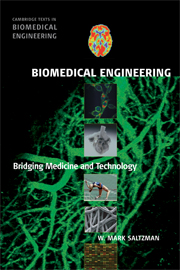Book contents
- Frontmatter
- Contents
- Preface
- Acknowledgments
- Abbreviations and Acronyms
- 1 Introduction: What Is Biomedical Engineering?
- PART 1 MOLECULAR AND CELLULAR PRINCIPLES
- 2 Biomolecular Principles
- 3 Biomolecular Principles: Nucleic Acids
- 4 Biomolecular Principles: Proteins
- 5 Cellular Principles
- PART 2 PHYSIOLOGICAL PRINCIPLES
- PART 3 BIOMEDICAL ENGINEERING
- Appendix A Physiological Parameters
- Appendix B Chemical Parameters
- Appendix C Units and Conversion Factors
- Index
- Plate section
- References
4 - Biomolecular Principles: Proteins
from PART 1 - MOLECULAR AND CELLULAR PRINCIPLES
- Frontmatter
- Contents
- Preface
- Acknowledgments
- Abbreviations and Acronyms
- 1 Introduction: What Is Biomedical Engineering?
- PART 1 MOLECULAR AND CELLULAR PRINCIPLES
- 2 Biomolecular Principles
- 3 Biomolecular Principles: Nucleic Acids
- 4 Biomolecular Principles: Proteins
- 5 Cellular Principles
- PART 2 PHYSIOLOGICAL PRINCIPLES
- PART 3 BIOMEDICAL ENGINEERING
- Appendix A Physiological Parameters
- Appendix B Chemical Parameters
- Appendix C Units and Conversion Factors
- Index
- Plate section
- References
Summary
LEARNING OBJECTIVES
After reading this chapter, you should:
Understand the concepts of primary, secondary, tertiary, and quaternary structure in proteins.
Understand the contribution of amino acid ionization to the structure of proteins.
Understand the role of disulfide bonds in stabilizing protein structure.
Recognize some of the methods used to determine the structure of proteins.
Understand how post-translational modifications such as glycosylation and myristoylation contribute to protein structure and function.
Understand the kinetics of enzyme action.
Prelude
Proteins are the workhorses of the cell (Figure 4.1): They provide structural support in the cytoskeleton, facilitate communication with other cells by acting as receptors, neutralize foreign pathogens, generate contraction forces in muscle, and most ubiquitously catalyze chemical reactions. Proteins are abundant in biological systems, such as eggs (Figure 4.2). Proteins are one of the major macronutrients in the human diet (Figure 4.3).
Some recombinant proteins now serve as therapeutic drugs for treatment or prevention of disease. Biomedical engineers also use recombinant proteins, such as growth factors, to promote growth and differentiation of cells in engineered tissues. Some biomedical engineers have been using techniques of protein engineering to design new biomaterials for use in tissue engineering, drug-delivery systems, or other medical applications.
This chapter describes the structure and function of proteins and also includes a brief introduction to some of the techniques used to determine protein structure, chiefly nuclear magnetic resonance (NMR) and x-ray crystallography. Researchers in the pharmaceutical industry use these protein structures in structure-guided drug design.
- Type
- Chapter
- Information
- Biomedical EngineeringBridging Medicine and Technology, pp. 141 - 167Publisher: Cambridge University PressPrint publication year: 2009



